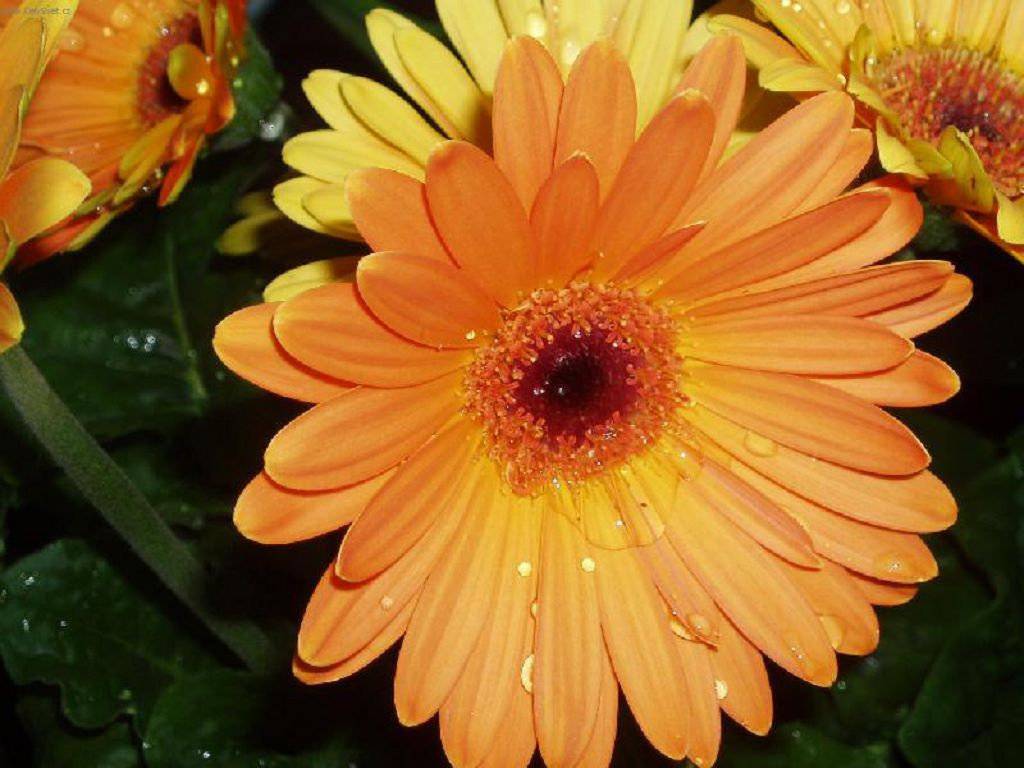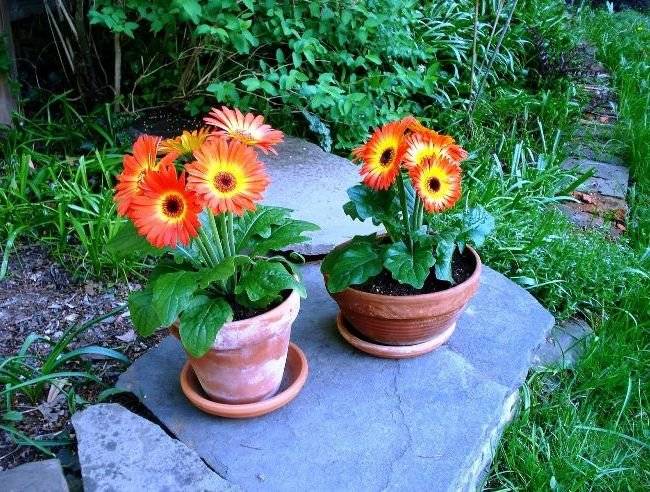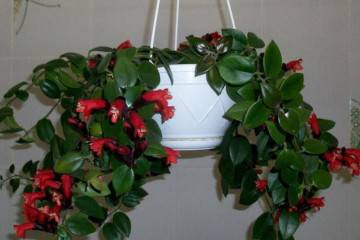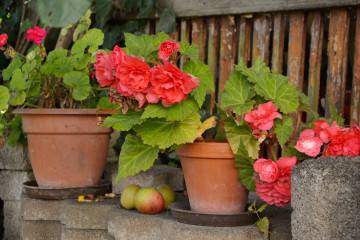Gerbera indoor - home care
Content:
Room gerbera, which is easy to care for at home, creates a unique atmosphere in the house and fills any apartment with bright, juicy shades. Increasingly, this plant appears on window sills, growers admire its appearance, and breeders are working on the creation of new hybrid varieties. It is easy to grow it, and the variety of hybrids will delight even the most fastidious grower.
Indoor gerbera - what is this flower
Gerbera is a perennial plant belonging to the Astrov family. The first meeting with her took place in South Africa. It is also common in Madagascar and Southeast Asia. Today, about 80 species of gerbera grow in natural conditions, most of which are re-flowering. The first flowering occurs at the end of spring, and the second at the beginning of autumn.
Short description
The gerbera plant has been known to biologists since the 18th century. It was first described by the Dutch botanist J. Gronovius. The flower owes its name to him. He received it in honor of the doctor and biologist Gerber Traugott, who lived in Moscow for a long time, researching the plants of the Volga region. He also served as director of the Moscow Botanical Garden. Domestic gerberas appeared only at the end of the 19th century. They were bred by the Scottish breeder R. Jameson.
Description of indoor gerbera:
- indoor gerberas grow no higher than 30 cm, while their natural relatives reach more than half a meter in height;
- the flower has the shape of a basket, its diameter is from 5 to 15 cm, the color is varied depending on the variety;
- leaves pinnately dissected, long and green with slight pubescence;
- at the end of flowering, fruits with seeds are formed. They are easy to assemble by yourself.
Despite the fact that the colors of the plant differ, even the shapes and types of flowers can differ, the only gerbera in the pot is the Jameson gerbera (Gerbera Gamesonii). This species served as the basis for many hybrid varieties, which now successfully occupy an honorable place on window sills. It is worth noting that this variety does not have a long life expectancy, so you need to take care of the reproduction of the flower in time. And to extend the time, you need to provide a home gerbera in a pot with decent care at home and create a comfortable atmosphere.
How to care for room gerbera at home
Taking care of a gerbera in pots, like many representatives of the Astrov family, is not very difficult, but there are some nuances. In particular, it is extremely important to provide it with a lot of warmth and light. But other indicators are also important to grow a flower.
Illumination and temperature conditions
The optimal daylight hours for a potted gerbera are at least 12 hours. Therefore, it is worth stocking up on UV and LED lamps in advance to care for the plant in winter and autumn, when there is not enough street lighting. However, during the summer period, the flower should be protected from the scorching rays of the sun at lunchtime.If the lighting does not match, it will be too much or, conversely, not enough, the gerbera will not bloom.
Throughout the growing season, the optimum temperature for growing potted flower varieties is 20-25 ° C. In winter, the temperature is reduced so that the plant can rest. During this period, 15 ° C is considered the best indicator. Sudden changes in temperature are poorly tolerated by gerbera.
Watering rules and humidity
During the entire growing season, it is necessary to water the gerbera moderately. It is very important to do this with water at the correct temperature. It should be warm enough to match the temperature of the ground. If it is not possible to do exactly the same, it is important to at least bring these indicators closer. Water must be settled, soft.
The frequency of watering is determined by the frequency of drying of the upper layer of the substrate. During the dormant period, the gerbera is watered much less often, only to avoid drying out the earthen coma. In winter and autumn, moisture stagnation in the soil should be avoided, otherwise the plant may die.
Gerbera is a plant that requires high air humidity, but spraying from a spray bottle is not allowed. Proper observance of this condition is a very important part of caring for a gerbera. The following methods can be used to increase the humidity level:
- wet peat or moss is placed in the pallet;
- open vessels with water or wet expanded clay are placed next to the pot;
- the air around is sprayed from a sprayer so that moisture does not touch the delicate leaves and flowers of the plant;
- a special air humidifier is purchased.
Top dressing and soil quality
A universal soil for flowering plants is suitable for growing indoor gerbera. The preferred acidity level is pH 5.5 - 6.0. When compiling the substrate yourself, it should be remembered that the soil should be nutritious, loose, with neutral or slightly low acidity. A good drainage layer is required at the bottom of the pot to avoid excess moisture.
Top dressing is carried out only at the beginning of the growing season, while the plant is gaining green mass and is actively growing. For this, special mineral complexes for flowering indoor plants are suitable. Magnesium sulfate is excellent fertilizer. If the gerbera is in a cool place, phosphoric solutions may be needed. We must not forget about this, then the plant will look great. From the beginning of autumn to the beginning of spring, fertilizers are not applied.
Flower container size
In order for the plant to bloom luxuriantly and intensely, it is worth picking up a cramped pot. Otherwise, all forces will be directed to the growth and development of the root system, while the aboveground part will develop poorly. The flowerpot must have at least one drainage hole, and it is better if there are several of them. The delicate flower does not tolerate stagnant water.
The pot in which the gerbera will grow can be of any shape. It is desirable that it be of medium width and depth. Natural materials are preferable, such as clay or ceramics, which will allow air to pass through. The best vessel volume is 1-2 liters.
Pruning and replanting
The plant does not need special pruning.During the rest period, it passes on its own, simultaneously dropping all unnecessary parts - yellowed leaves and wilted flowers. The main task of the grower is to remove dried parts from plants on time and carefully. Accordingly, the whole pruning procedure is to remove dying flowers and leaves.
Gerbera is transplanted every year at the beginning of the growing season - in the spring, as soon as the first green leaves begin to appear. The pot should increase in diameter, but it should be deepened to the same level. The transfer is carried out by the transshipment method. During the process, in no case should the root system be damaged, the earth is not shaken off the previous coma. A little of the upper part of the soil is removed, and the resulting gaps are filled with new soil mixture.
The answer to the question of how to care for a gerbera in a pot turned out to be simple and straightforward. Even a novice florist can cope with this, if desired.
Features of flowering plants
Since the natural habitat of the gerbera assumes a long daylight hours, up to 14 hours, the flowering is long and rather lush. In nature, two waves are possible in 1 season. The domestic gerbera has not gone so far from its relatives, but in order for it to bloom for a long time, it is necessary to observe conditions as close as possible to natural ones.
A period of activity and rest
The period of active vegetative development begins in mid-February, when it awakens after winter sleep. At this time, the formation and growth of green mass begins, as well as the accumulation of forces for flowering. It begins in August and lasts until the end of autumn. If the necessary conditions are maintained, the gerbera will live for about 3-4 years, after which it will still die, since the period of the flower's life is short-lived, and it is impossible to extend it. But it can be shortened. This is not only due to insufficient care, but also due to its excess. Many flower growers like to create conditions under which indoor gerbera blooms almost all year round. In this case, the reserve of strength is depleted, and, having lived a maximum of 2 years, the flower dies.
Winter is a dormant period when the plant is resting. At this time, he needs minimal watering, no additional fertilizing, but a long daylight hours.
Types and shape of flowers
The shape of the flowers is a basket, in a large core of which there are flowers resembling petals rolled into a tube. Based on the fact that these are not petals, but flowers, the basket is a whole inflorescence. In terms of severity, they greatly exceed the fragile stalk, therefore, in any uncomfortable situation, they lean down. In terms of their size, the flowers are divided into small-flowered and large-flowered, in shape - simple and double. Simple ones resemble chamomile, and terry ones are more like asters. The petals can be wide or narrow.
Reproduction of a flower by dividing a bush
Since the life of this plant is short, and by the end of life, presentability is also lost, the flowers become small, their number decreases, it is worth thinking about reproduction of room gerbera. This process is simple, carried out using cuttings, dividing the bush and using the seed method. Dividing a bush is the simplest and most common breeding option. The procedure is carried out at the end of summer flowering and before the plant is completely dormant. The gerbera is pulled out of the pot, the root system is cleaned, and the young roots are divided into sharp, disinfected knives.The number of divisions may be different, but it is important that each of them has at least 2 growth buds.
Is it possible to propagate a flower by seeds
The seed method of gerbera propagation is used less often, but it is still used in practice. Everything happens in the same way as when germinating seeds of other plants: sowing is carried out in prepared moist soil, the seeds are lightly sprinkled with a layer of soil, covered with film or glass, and placed in a warm, bright place. The greenhouse is periodically opened to moisturize the substrate and ventilate. However, there are some nuances. First, the properties of the mother plant are unlikely to be transferred to the daughter plant, since most varieties are Jamson gerbera hybrids. Secondly, the seeds must be freshly harvested. Their ability to grow lasts only 4 months after harvest. The fresher the seeds, the higher the germination rate.
Growing problems, diseases and pests
If the gerbera is properly maintained and well taken care of, then diseases will bypass her. The plant's immunity is strong enough. Fungal infections can occur with improper care. Most often it is late blight and fusarium. Of the pests, aphids and spider mites are most likely.
How to deal with them
To combat diseases, it is worth working hard to create the most comfortable conditions for the existence of a flower. If the need arises, some parts of the plant will have to be removed. In case of waterlogging, you will need to transplant the flower into another pot; before the procedure, the earthen lump should be dried. To combat parasitic insects, flower treatment is used with special insecticides, which can be easily purchased at flower shops.
Indoor gerbera has become widespread in many countries, including Russia. Despite the fact that she appeared here only a few years ago, she can be found in every flower shop and on many window sills. She helps out all lovers of cut gerbera, and also serves as an original gift. The gerbera flower is easy to care for, it is easy to grow it, and the bloom will delight you with its bright colors that diversify the dull autumn weekdays.























